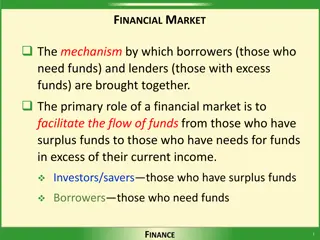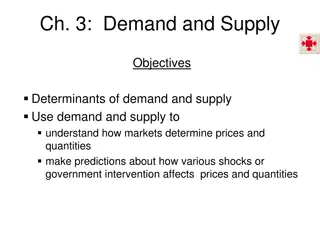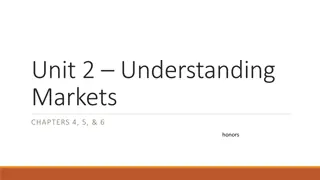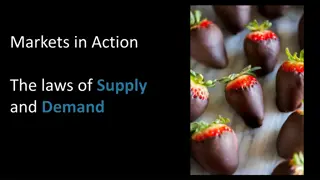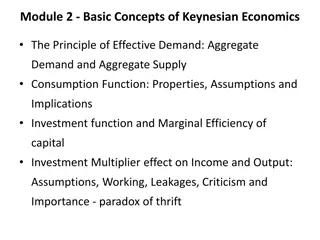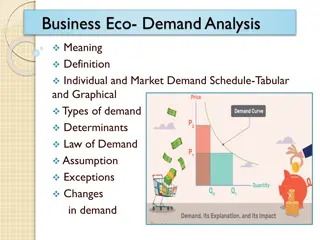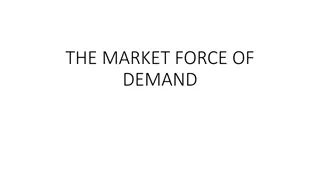Understanding Supply and Demand in Competitive Markets
The images prepared by Ms. Khadija Alaa from Ishik University illustrate the impact of supply and demand on market prices in various scenarios, such as cold waves affecting kerosene prices and wars influencing gasoline costs. The content explains how buyers and sellers interact in competitive markets, determining the equilibrium prices based on the principles of supply and demand. Additionally, it explores the concept of competition where numerous buyers and sellers contribute to price control in the market.
Download Presentation

Please find below an Image/Link to download the presentation.
The content on the website is provided AS IS for your information and personal use only. It may not be sold, licensed, or shared on other websites without obtaining consent from the author. Download presentation by click this link. If you encounter any issues during the download, it is possible that the publisher has removed the file from their server.
E N D
Presentation Transcript
Supply and Demand When a cold wave hits Kurdistan, the price of kerosene rises throughout the region. Why? Prepared by Ms. Khadija Alaa, FASE, Ishik University
Supply and Demand When the weather turns warm in the country every summer, the price of hotel rooms in the resorts rises. Prepared by Ms. Khadija Alaa, FASE, Ishik University
Supply and Demand When a war breaks out in the Middle East, the price of gasoline in the United States rises and the price of a used Cadillac falls. Prepared by Ms. Khadija Alaa, FASE, Ishik University
What do these events have in common? They all show the workings of supply and demand. Prepared by Ms. Khadija Alaa, FASE, Ishik University
The terms demand and supply refer to the behavior of people as they interact with one another in competitive markets. A market is a group of buyers and sellers of a particular good or service. The buyers as a group determine the demand for the product, and the sellers as a group determine the supply of the product. Prepared by Ms. Khadija Alaa, FASE, Ishik University
What Is Competition? Economists use the term competitive market to describe a market in which there are so many buyers and so many sellers that each has an insignificant impact on the market price. Each seller of ice cream has limited control over the price because other sellers are offering similar products. Prepared by Ms. Khadija Alaa, FASE, Ishik University
Who decides the market prices? A seller has little reason to charge less than the going price, and if he charges more, buyers will make their purchases elsewhere. Similarly, no single buyer of ice cream can influence the price of ice cream because each buyer purchases only a small amount. Prepared by Ms. Khadija Alaa, FASE, Ishik University
In this chapter, we assume that markets are perfectly competitive. To reach this highest form of competition, a market must have two characteristics: The goods offered for sale are all exactly the same. The buyers and sellers are so numerous that no single buyer or seller has any influence over the market price. Because buyers and sellers in perfectly competitive markets must accept the price the market determines, they are said to be price takers. At the market price, buyers can buy all they want, and sellers can sell all they want. Prepared by Ms. Khadija Alaa, FASE, Ishik University
Demand The quantity demanded of any good is the amount of the good that buyers are willing and able to purchase. As we will see, many things determine the quantity demanded of any good, but in our analysis of how markets work, one determinant plays a central role the price of the good. If the price of ice cream rose to $20 per scoop, you would buy less ice cream. You might buy frozen yogurt instead. If the price of ice cream fell to $0.20 per scoop, you would buy more. This relationship between price and quantity demanded is true for most goods in the Economy. Prepared by Ms. Khadija Alaa, FASE, Ishik University
Quantity Demanded: the amount of a good that buyers are willing and able to purchase. Law Of Demand: the claim that, other things being equal, the quantity demanded of a good falls when the price of the good rises. Demand Schedule: a table that shows the relationship between the price of a good and the quantity demanded. Demand Curve: a graph of the relationship between the price of a good and the quantity demanded. Prepared by Ms. Khadija Alaa, FASE, Ishik University
Market Demand versus Individual Demand The demand curve in Figure 1 shows an individual s demand for a product. To analyze how markets work, we need to determine the market demand, the sum of all the individual demands for a particular good or service. Prepared by Ms. Khadija Alaa, FASE, Ishik University
Shifts in the Demand Curve Shifts in the Demand Curve What shifts the demand curve? Income, prices of related goods (complements or substitutes), tastes or preferences, expectations, population or number of buyers. Prepared by Ms. Khadija Alaa, FASE, Ishik University
Income What would happen to your demand for ice cream if you lost your job one summer? Most likely, it would fall. A lower income means that you have less to spend in total, so you would have to spend less on some and probably most goods. If the demand for a good falls when income falls, the good is called a normal good. Not all goods are normal goods. If the demand for a good rises when income falls, the good is called an inferior good. An example of an inferior good might be bus rides. As your income falls, you are less likely to buy a car or take a cab and more likely to ride a bus. Prepared by Ms. Khadija Alaa, FASE, Ishik University
Prices of Related Goods Prices of Related Goods Suppose that the price of frozen yogurt falls. The law of demand says that you will buy more frozen yogurt. At the same time, you will probably buy less ice cream. Because ice cream and frozen yogurt are both cold, sweet, creamy desserts, they satisfy similar desires. When a fall in the price of one good reduces the demand for another good, the two goods are called substitutes. Substitutes are often pairs of goods that are used in place of each other, such as hot dogs and hamburgers, sweaters and sweatshirts, and movie tickets and DVD rentals. Now suppose that the price of hot fudge falls. According to the law of demand, you will buy more hot fudge. Yet in this case, you will likely buy more ice cream as well because ice cream and hot fudge are often used together. When a fall in the price of one good raises the demand for another good, the two goods are called complements. Complements are often pairs of goods that are used together, such as gasoline and automobiles, computers and software, and peanut butter and jelly. Prepared by Ms. Khadija Alaa, FASE, Ishik University
Tastes or Preferences Tastes or Preferences The most obvious determinant of your demand is your tastes. If you like ice cream, you buy more of it. Economists normally do not try to explain people s tastes because tastes are based on historical and psychological forces that are beyond the realm of economics. Economists do, however, examine what happens when tastes change. Prepared by Ms. Khadija Alaa, FASE, Ishik University
Expectations Expectations Your expectations about the future may affect your demand for a good or service today. If you expect to earn a higher income next month, you may choose to save less now and spend more of your current income buying ice cream. If you expect the price of ice cream to fall tomorrow, you may be less willing to buy an ice-cream cone at today s price. Prepared by Ms. Khadija Alaa, FASE, Ishik University
Number of Number of Buyers or Population Buyers or Population In addition to the preceding factors, which influence the behavior of individual buyers, market demand depends on the number of these buyers. If Peter were to join Catherine and Nicholas as another consumer of ice cream, the quantity demanded in the market would be higher at every price, and market demand would increase. Prepared by Ms. Khadija Alaa, FASE, Ishik University
Supply The quantity supplied of any good or service is the amount that sellers are willing and able to sell. There are many determinants of quantity supplied, but once again, price plays a special role in our analysis. When the price of ice cream is high, selling ice cream is profitable, and so the quantity supplied is large. Sellers of ice cream work long hours, buy many ice-cream machines, and hire many workers. By contrast, when the price of ice cream is low, the business is less profitable, so sellers produce less ice cream. At a low price, some sellers may even choose to shut down, and their quantity supplied falls to zero. Prepared by Ms. Khadija Alaa, FASE, Ishik University
Quantity Supplied: the amount of a good that sellers are willing and able to sell. Law Of Supply: the claim that, other things being equal, the quantity supplied of a good rises when the price of the good rises. Supply Schedule: a table that shows the relationship between the price of a good and the quantity supplied. Supply Curve: a graph of the relationship between the price of a good and the quantity supplied. Prepared by Ms. Khadija Alaa, FASE, Ishik University
Market Supply versus Individual Supply Just as market demand is the sum of the demands of all buyers, market supply is the sum of the supplies of all sellers. Prepared by Ms. Khadija Alaa, FASE, Ishik University
Shifts in the Supply Curve Shifts in the Supply Curve What shifts the supply curve? Input Prices, Technology, Expectations, Number of Sellers, State of nature Prepared by Ms. Khadija Alaa, FASE, Ishik University
Input Prices Input Prices To produce their output of ice cream, sellers use various inputs: cream, sugar, flavoring, ice-cream machines, the buildings in which the ice cream is made, and the labor of workers to mix the ingredients and operate the machines. When the price of one or more of these inputs rises, producing ice cream is less profitable, and firms supply less ice cream. If input prices rise significantly, a firm might shut down and supply no ice cream at all. Thus, the supply of a good is negatively related to the price of the inputs used to make the good. Prepared by Ms. Khadija Alaa, FASE, Ishik University
Technology Technology The technology for turning inputs into ice cream is another determinant of supply. The invention of the mechanized ice-cream machine, for example, reduced the amount of labor necessary to make ice cream. By reducing firms costs, the advance in technology raised the supply of ice cream. Prepared by Ms. Khadija Alaa, FASE, Ishik University
Expectations Expectations The amount of ice cream a firm supplies today may depend on its expectations about the future. For example, if a firm expects the price of ice cream to rise in the future, it will put some of its current production into storage and supply less to the market today. Prepared by Ms. Khadija Alaa, FASE, Ishik University
Number of Sellers Number of Sellers In addition to the preceding factors, which influence the behavior of individual sellers, market supply depends on the number of these sellers. If Ben or Jerry were to retire from the ice-cream business, the supply in the market would fall. Prepared by Ms. Khadija Alaa, FASE, Ishik University
State of nature State of nature The state of nature includes all the natural forces that influence production for example, the weather. A natural disaster decreases supply and shifts the supply curve leftward. Prepared by Ms. Khadija Alaa, FASE, Ishik University
Supply and Demand Together Equilibrium: a situation in which the market price has reached the level at which quantity supplied equals quantity demanded. Equilibrium Price: the price that balances quantity supplied and quantity demanded. Equilibrium Quantity: the quantity supplied and the quantity demanded at the equilibrium price. Surplus: a situation in which quantity supplied is greater than quantity demanded. Prepared by Ms. Khadija Alaa, FASE, Ishik University
Example: A Change in Market Equilibrium Due to a Shift in Demand. Suppose that one summer the weather is very hot. How does this event affect the market for ice cream? To answer this question, let s follow our three steps. 1. The hot weather affects the demand curve by changing people s taste for ice cream. That is, the weather changes the amount of ice cream that people want to buy at any given price. The supply curve is unchanged because the weather does not directly affect the firms that sell ice cream. Prepared by Ms. Khadija Alaa, FASE, Ishik University
2. Because hot weather makes people want to eat more ice cream, the demand curve shifts to the right. Figure 10 shows this increase in demand as a shift in the demand curve from D1 to D2. This shift indicates that the quantity of ice cream demanded is higher at every price. 3. At the old price of $2, there is now an excess demand for ice cream, and this shortage induces firms to raise the price. As Figure 10 shows, the increase in demand raises the equilibrium price from $2.00 to $2.50 and the equilibrium quantity from 7 to 10 cones. In other words, the hot weather increases the price of ice cream and the quantity of ice cream sold. Prepared by Ms. Khadija Alaa, FASE, Ishik University
Example: A Change in Market Equilibrium Due to a Shift in Supply. Suppose that during another summer, a hurricane destroys part of the sugarcane crop and drives up the price of sugar. How does this event affect the market for ice cream? Once again, to answer this question, we follow our three steps. 1. The change in the price of sugar, an input for making ice cream, affects the supply curve. By raising the costs of production, it reduces the amount of ice cream that firms produce and sell at any given price. The demand curve does not change because the higher cost of inputs does not directly affect the amount of ice cream households wish to buy. Prepared by Ms. Khadija Alaa, FASE, Ishik University
2. The supply curve shifts to the left because, at every price, the total amount that firms are willing and able to sell is reduced. Figure 11 illustrates this decrease in supply as a shift in the supply curve from S1 to S2. 3. At the old price of $2, there is now an excess demand for ice cream, and this shortage causes firms to raise the price. As Figure 11 shows, the shift in the supply curve raises the equilibrium price from $2.00 to $2.50 and lowers the equilibrium quantity from 7 to 4 cones. As a result of the sugar price increase, the price of ice cream rises, and the quantity of ice cream sold falls. Prepared by Ms. Khadija Alaa, FASE, Ishik University
Question Bank Describe changes and possible shifts in supply and demand and their subsequent effect on equilibrium market price and quantity of Jli Kurdi in the Bazar in the following scenarios: 1.The sewing machine is invented and becomes affordable. 2. Through the example of Kurdish film and music stars, Jli Kurdi becomes associated worldwide with success and professionalism. 3. Klash (the traditional shoes) are suddenly cheaper. 4. It is publicized that the boll weevil, an insect that destroys cotton plants, has become highly resistant to all pesticides. 5. The KRG decides to share more of the oil revenue directly with the citizens by sending them all cash. Prepared by Ms. Khadija Alaa, FASE, Ishik University
Question Bank This post goes over a common supply and demand shifters in a coffee market context, and how each of the following events will affect market for coffee: a) a blight on coffee plants kills off much of the Brazilian crop. b) coffee workers organize themselves into a union and gain higher wages. c) coffee is shown to cause cancer in laboratory rats. d) price of tea declines. e) Coffee prices are expected to rise rapidly in the near future. Prepared by Ms. Khadija Alaa, FASE, Ishik University



